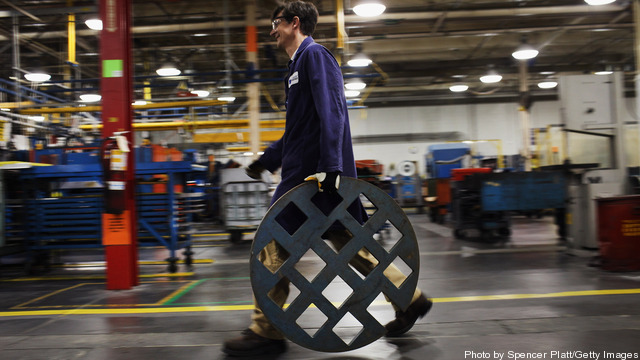 A man works on the factory floor at Quadrant, a high end plastic processor on October 19, 2011 in Reading, Pennsylvania. Quadrant, a 70 year old company, employs more than 2000 people in 20 countries and is one of the few remaining manufacturers in the area to still provide stable jobs in an uncertain economy.
A man works on the factory floor at Quadrant, a high end plastic processor on October 19, 2011 in Reading, Pennsylvania. Quadrant, a 70 year old company, employs more than 2000 people in 20 countries and is one of the few remaining manufacturers in the area to still provide stable jobs in an uncertain economy.
Modern manufacturing is not your grandfather’s factory, and the same traditional education and immigration policies are forming barriers to keeping manufacturing in the US.
That was the message from business and university leaders at the Feb. 27-29 Energy Innovation Summit, sponsored by the Department of Energy’s Advanced Research Projects Agency-Energy.
Energy Secretary Steven Chu, opening the summit, identified making the nation’s undisputed lead in technology innovation produce domestic manufacturing as a major national challenge.
Business leaders pointed to education and immigration policies as major hurdles. Read more about the transforming energy sector from Steven Chu on Breaking Energy here.
They said today’s manufacturing jobs require education beyond high school, plus specialized training, to operate the high-tech machinery on a shop floor and engineer improvements to processes on an ongoing basis.
For instance, said Matthew Ganz of Boeing, aircraft workers drill thousands of holes daily while assembling high-tech components, but one misdrilled hole can cost Boeing millions.
Gains Create STEMulation
US manufacturing has made “enormous” productivity gains, said Susan Hockfield, President of the Massachusetts Institute of Technology, so the 10% of the US workforce now in manufacturing produces the same value output as China’s far larger manufacturing sector.
But other nations have emulated what the US did since World War II in education, Hockfield said, and students in at least 17 countries have bypassed US students in the STEM (science, technology, engineering and mathematics) fields vital to technology advances.
“The rest of the world is stepping up on STEM education,” said Ganz, adding universities in other countries are now luring away the best US professors.
Atul Kapadia of Envia said finding high-tech skills is a “bottleneck” for companies considering manufacturing in the US. He said the nation needs to “celebrate engineers” to excite more potential students. Read more about Envia’s new technology on Breaking Energy here.
Christine Furstoss of GE said the US needs to “re-grow pride in education.”
Hockfield said the cycles of education and technology funding, which rise and fall with US politics, can have “devastating effects.” Lack of study and research opportunities in a field in one or two years means potential students those years are lost forever.
Consistent government support is needed to let the best students stay in STEM fields, Hockfield said.
Immigration Indignities
Making the skilled labor situation worse for business are US immigration policies.
A quarter century ago, the US was “the place to be,” Hockfield said, and science graduates who came from other countries would submit to the “indignities” of US immigration in order to work here.
The immigration system hasn’t changed, but the brightest foreign students have increasing options elsewhere, she said, and they’re taking them.
Ganz described an immigration “nightmare” for Boeing as it tried to hire a brilliant science graduate of a top US university who came from a “friendly country.” Immigration policies that force top foreign students to leave, he said, “mean we can’t hire the best.”
Bruce Sohn of MEGE Associates, formerly an executive with Intel, said one simple fix is to give every science graduate of a US university who isn’t a citizen a green card with his or her diploma. That approach is backed by President Obama but so far has not passed Congress.
“The US can’t sit back and use a 1960s model” in this century, warned Hockfield.
She sees manufacturing as “ripe for exciting gains” and for “remaking how we make things,” but that requires bringing breakthrough talent to bear.
Ursula Burns, CEO of Xerox, drew some gasps from the summit audience when she said STEM education is so important to the US future that it should be nationalized.
“The brain power to build a sustainable world is here,” Burns said, adding, “I have an abiding belief our best days are ahead of us.”
This is the second story in a two-part series evaluating the outcomes of the government’s energy innovation summit. Read here for part one.
